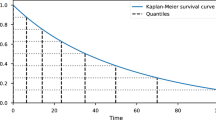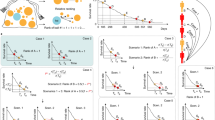Abstract
Time-to-event prediction has been an important practical task for longitudinal studies in many fields such as manufacturing, medicine, and healthcare. While most of the conventional survival analysis approaches suffer from the presence of censored failures and statistically circumscribed assumptions, few attempts have been made to develop survival learning machines that explore the underlying relationship between repeated measures of covariates and failure-free survival probability. This requires a purely dynamic-data-driven prediction approach, free of survival models or statistical assumptions. To this end, we propose two real-time survival networks: a time-dependent survival neural network (TSNN) with a feed-forward architecture and a recurrent survival neural network (RSNN) incorporating long short-term memory units. The TSNN additively estimates a latent failure risk arising from the repeated measures and performs multiple binary classifications to generate prognostics of survival probability, while the RSNN with time-dependent input covariates implicitly estimates the relation between these covariates and the survival probability. We propose a novel survival learning criterion to train the neural networks by minimizing the censoring Kullback–Leibler divergence, which guarantees monotonicity of the resulting probability. Besides the failure-event AUC, C-index, and censoring Brier score, we redefine a survival time estimate to evaluate the performance of the competing models. Experiments on four datasets demonstrate the great promise of our approach in real applications.









Similar content being viewed by others
Explore related subjects
Discover the latest articles and news from researchers in related subjects, suggested using machine learning.References
Aalen O (1978) Nonparametric estimation of partial transition probabilities in multiple decrement models. Ann Stat 6:534–545
Alaa AM, van der Schaar M (2017) Deep multi-task Gaussian processes for survival analysis with competing risks. In: Proceedings of the annual conference on neural information processing systems (NIPS), pp 2326–2334
Bellot A, van der Schaar M (2018) Multitask boosting for survival analysis with competing risks. In: Proceedings of the annual conference on neural information processing systems (NIPS), pp 1397–1406
Biganzoli E, Boracchi P, Mariani L, Marubini E (1998) Feed forward neural networks for the analysis of censored survival data: a partial logistic regression approach. Stat Med 17(10):1169–1186
Binder H, Schumacher M (2008) Allowing for mandatory covariates in boosting estimation of sparse high-dimensional survival models. BMC Bioinform 9(1):14
Buckley J, James I (1979) Linear regression with censored data. Biometrika 66(3):429–436
Caruana EJ, Roman M, Hernández-Sánchez J, Solli P (2015) Longitudinal studies. J Thorac Dis 7(11):E537
Chen L, Wang S (2013) Central clustering of categorical data with automated feature weighting. In: Proceedings of the international joint conference on artificial intelligence (IJCAI), pp 1260–1266
Chen Q, May RC, Ibrahim JG, Chu H, Cole SR (2014) Joint modeling of longitudinal and survival data with missing and left-censored time-varying covariates. Stat Med 33(26):4560–4576
Cox DR (1972) Regression models and life tables. J R Stat Soc Ser B (Stat Methodol) 34:187–220
Cutler SJ, Ederer F (1958) Maximum utilization of the life table method in analyzing survival. J Chronic Dis 8(6):699
Fan J, Zhang W (2008) Statistical methods with varying coefficient models. Stat Interface 1(1):179
Faraggi D, Simon R (1995) A neural network model for survival data. Stat Med 14(1):73–82
Fernández T, Rivera N, Teh YW (2016) Gaussian processes for survival analysis. In: Proceedings of the annual conference on neural information processing systems (NIPS), pp 5021–5029
Fisher LD, Lin DY (1999) Time-dependent covariates in the Cox proportional-hazards regression model. Annu Rev Public Health 20(1):145–157
Giunchiglia E, Nemchenko A, van der Schaar M (2018) RNN-SURV: a deep recurrent model for survival analysis. In: International conference on artificial neural networks (ICANN), pp 23–32. Springer, Berlin
Grob GL, Cardoso Â, Liu CB, Little DA, Chamberlain BP (2018) A recurrent neural network survival model: predicting web user return time. In: Proceedings of the European conference on machine learning and principles and practice of knowledge discovery in databases (ECML PKDD), pp 152–168. Springer, Berlin
Hochreiter S, Schmidhuber J (1997) Long short-term memory. Neural Comput 9(8):1735–1780
Ishwaran H, Kogalur UB, Blackstone EH, Lauer MS (2008) Random survival forests. Ann Appl Stat 2:841–860
Jenkins SP (2005) Survival analysis. Unpublished Manuscript, Institute for Social and Economic Research, Chapter 3, University of Essex, Colchester, UK
Kaplan EL, Meier P (1958) Nonparametric estimation from incomplete observations. J Am Stat Assoc (JASA) 53(282):457–481
Katzman J, Shaham U, Bates J, Cloninger A, Jiang T, Kluger Y (2018) DeepSurv: personalized treatment recommender system using a Cox proportional hazards deep neural network. BMC Med Res Methodol 18:24
Kim H, Golub GH, Park H (2004) Imputation of missing values in DNA microarray gene expression data. In: CSB, pp 572–573
Kim M, Pavlovic V (2018) Variational inference for Gaussian process models for survival analysis. In: Proceedings of the annual conference on uncertainty in artificial intelligence (UAI), pp 435–445
Lee C, Zame WR, Yoon J, van der Schaar M (2018) Deephit: a deep learning approach to survival analysis with competing risks. In: Proceedings of the AAAI national conference on artificial intelligence (AAAI), pp 2314–2321
Li H, Ge Y, Zhu H, Xiong H, Zhao H (2017a) Prospecting the career development of talents: a survival analysis perspective. In: Proceedings of the ACM SIGKDD international conference on knowledge discovery and data mining (KDD), pp 917–925
Li Y, Wang J, Ye J, Reddy CK (2016a) A multi-task learning formulation for survival analysis. In: Proceedings of the ACM SIGKDD international conference on knowledge discovery and data mining (KDD), pp 1715–1724
Li Y, Wang L, Wang J, Ye J, Reddy CK (2017b) Transfer learning for survival analysis via efficient l2,1-norm regularized Cox regression. In: Proceedings of the IEEE international conference on data mining (ICDM), pp 231–240
Li Y, Xu KS, Reddy CK (2016b) Regularized parametric regression for high-dimensional survival analysis. In: Proceedings of the SIAM international conference on data mining (SDM), pp 765–773
Liestbl K, Andersen PK, Andersen U (1994) Survival analysis and neural nets. Stat Med 13(12):1189–1200
Lin H-C, Baracos V, Greiner R, Chun-nam JY (2011) Learning patient-specific cancer survival distributions as a sequence of dependent regressors. In: Proceedings of the annual conference on neural information processing systems (NIPS), pp 1845–1853
Liu M, Lu W, Shore RE, Zeleniuch-Jacquotte A (2010) Cox regression model with time-varying coefficients in nested case–control studies. Biostatistics 11(4):693–706
Michalewicz Z, Schoenauer M (1996) Evolutionary algorithms for constrained parameter optimization problems. Evolut Comput 4(1):1–32
Moghaddass R, Rudin C (2014) The latent state hazard model, with application to wind turbine reliability. Ann Appl Stat 9(4):1823–1863
Rumelhart DE, Hinton GE, Williams RJ (1988) Neurocomputing: foundations of research. Chapter Learning representations by back-propagating errors. MIT Press, Cambridge, pp 696–699
Street WN (1998) A neural network model for prognostic prediction. In: Proceedings of the annual international conference on machine learning (ICML), pp 540–546
Sun Y, Sundaram R, Zhao Y (2009) Empirical likelihood inference for the Cox model with time-dependent coefficients via local partial likelihood. Scand J Stat 36(3):444–462
Thomas L, Reyes EM (2014) Tutorial: survival estimation for Cox regression models with time-varying coefficients using SAS and R. J Stat Softw 61(c1):1–23
Tian L, Zucker D, Wei L (2005) On the Cox model with time-varying regression coefficients. J Am Stat Assoc (JASA) 100(469):172–183
Tibshirani R et al (1997) The LASSO method for variable selection in the Cox model. Stat Med 16(4):385–395
Vinzamuri B, Li Y, Reddy CK (2014) Active learning based survival regression for censored data. In: Proceedings of the ACM international conference on information and knowledge management (CIKM), pp 241–250
Vinzamuri B, Reddy CK (2013) Cox regression with correlation based regularization for electronic health records. In: Proceedings of the IEEE international conference on data mining (ICDM), pp 757–766
Wang L, Li Y, Zhou J, Zhu D, Ye J (2017) Multi-task survival analysis. In: Proceedings of the IEEE international conference on data mining (ICDM), pp 485–494
Wang W (2004) Proportional hazards regression models with unknown link function and time-dependent covariates. Stat Sin 14(3):885–906
Wei L-J (1992) The accelerated failure time model: a useful alternative to the Cox regression model in survival analysis. Stat Med 11(14–15):1871–1879
Wilamowski BM, Yu H (2010) Neural network learning without backpropagation. IEEE Trans Neural Netw (TNN) 21(11):1793–1803
Wu Y, Yuan M, Dong S, Lin L, Liu Y (2018) Remaining useful life estimation of engineered systems using vanilla LSTM neural networks. Neurocomputing 275:167–179
Yamashita H, Tanabe T (2010) A primal-dual exterior point method for nonlinear optimization. SIAM J Optim (SIOPT) 20(6):3335–3363
Yang G, Cai Y, Reddy CK (2018) Spatio-temporal check-in time prediction with recurrent neural network based survival analysis. In: Proceedings of the international joint conference on artificial intelligence (IJCAI), pp 2976–2983
Yu S, Fung G, Rosales R, Krishnan S, Rao RB, Dehing-Oberije C, Lambin P (2008) Privacy-preserving Cox regression for survival analysis. In: Proceedings of the ACM SIGKDD international conference on knowledge discovery and data mining (KDD), pp 1034–1042
Zhang D (2008) Analysis of survival data (chapter 10: time dependent covariates). https://www.coursehero.com/file/18367916/chap10/
Zhang J, Chen L, Vanasse A, Courteau J, Wang S (2016a) Survival prediction by an integrated learning criterion on intermittently varying healthcare data. In: Proceedings of the AAAI national conference on artificial intelligence (AAAI), pp 72–78
Zhang J, Wang S, Chen L, Guo G, Chen R, Vanasse A (2019) Time-dependent survival neural network for remaining useful life prediction. In: Proceedings of the Pacific-Asia conference on knowledge discovery and data mining (PAKDD), pp 441–452. Springer, Berlin
Zhang J, Wang S, Courteau J, Chen L, Bach A, Vanasse A (2016b) Predicting COPD failure by modeling hazard in longitudinal clinical data. In: Proceedings of the IEEE international conference on data mining (ICDM), pp 639–648
Zhang Z, Reinikainen J, Adeleke KA, Pieterse ME, Groothuis-Oudshoorn CG (2018) Time-varying covariates and coefficients in Cox regression models. Ann Transl Med 6(7):121
Zhou M (2001) Understanding the Cox regression models with time-change covariates. Am Stat 55(2):153–155
Zou H, Hastie T (2005) Regularization and variable selection via the elastic net. J R Stat Soc Ser B (Stat Methodol) 67(2):301–320
Acknowledgements
This work was partially supported by the Natural Sciences and Engineering Research Council of Canada (NSERC) under Grant 396097-2015, the National Natural Science Foundation of China (NSFC) under Grants U1805263 and 61672157, the Canadian Institutes of Health Research (CIHR) under Grant 391051, the Fonds de Recherche du Québec-Santé, and the Département de médecine de famille et de médecine d’urgence at the Université de Sherbrooke. Part of this work was done while Jianfei Zhang was doing research in CWRU with Yanfang Ye. Jianfei Zhang and Yanfang Ye’s work is partially supported by the National Science Foundation (NSF) under Grants IIS-1951504, CNS-1940859, CNS-1946327, CNS-1814825, and OAC-1940855, the Department of Justice/ National Institute of Justice (DoJ/NIJ) under Grant NIJ 2018-75-CX-0032, and the Institute for Smart, Secure and Connected Systems (ISSACS) at CWRU and Cleveland Foundation under Grant 292767.
Author information
Authors and Affiliations
Corresponding author
Additional information
Publisher's Note
Springer Nature remains neutral with regard to jurisdictional claims in published maps and institutional affiliations.
Rights and permissions
About this article
Cite this article
Zhang, J., Chen, L., Ye, Y. et al. Survival neural networks for time-to-event prediction in longitudinal study. Knowl Inf Syst 62, 3727–3751 (2020). https://doi.org/10.1007/s10115-020-01472-1
Received:
Revised:
Accepted:
Published:
Issue Date:
DOI: https://doi.org/10.1007/s10115-020-01472-1




